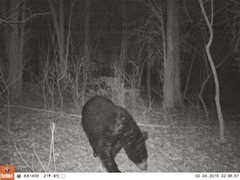I never found out the real answer to my own question, but I did realize that my Facebook usage is unlike most people's. I use Facebook and Twitter to track wildlife. I do it all the time by just being connected.
Facebook has "Groups" and "Pages" for those of you who are unfamiliar with the website. You can join these groups and see exactly what people post to the public. Groups range from hobbyist groups, to family groups, and even classmates in a specific college class or study groups. Pages are a bit different, but with a similar concept. We'll leave pages for another day.
 |
| Black bear reported to the public on Facebook |
People post all kinds of important information on the whereabouts of all sorts of species. Most posts regarding wildlife have to do with what comes up to bird feeders, "too many deer", red fox appearances, and the occasional coyote post from around the area. Once in a while black bears and bobcats are talked about, and very rarely, someone will post something about a mountain lion.
All of these sightings are important to me. It helps me out with my trail camera surveys and gives me an opportunity to talk to private property owners about what is really around here. What usually happens in situations where I see people posting about wildlife sightings, is that I will comment that I'm interested and take it from there. Sometimes this leads to me trusting the people enough to get the chance at putting up a trail camera on their property.
I find it fascinating to not only see what people see, but also to see what they completely miss. It's incredible how many animals seem to "go under the radar" of lots of people. I have known about bears, bobcats, and whole packs of coyotes that visit people's yards. Some visit almost every single night, and people never even know.
A good way to skip through posts not having to deal with wildlife is to go on the specific Facebook group and hit the "search" bar up top. I type in words such as "coyote", "bear", and "wildlife" and all kinds of stuff may come up. This is usually done once a week on my areas' that I cover on wildlife sightings and trail cameras. It is something that is free and doesn't take much time at all. For those two reasons, it is well worth it for me to do this.
A large portion of the work I do covers sightings and opportunities that come directly from my bosses in the parks and wildlife careers. Tracking wildlife through social media is an opportunity that takes me off the beaten path of professional animal sightings and is a whole "science" in itself. It's amazing.












